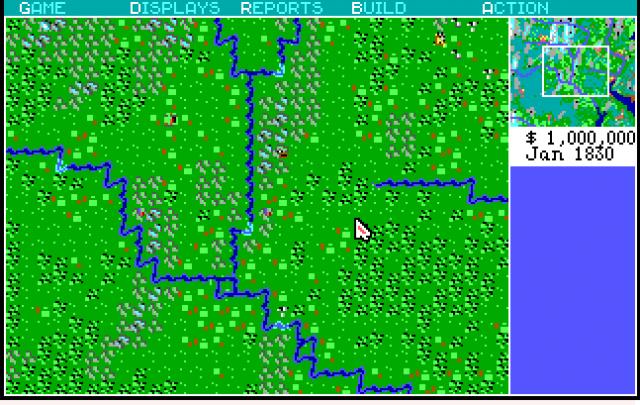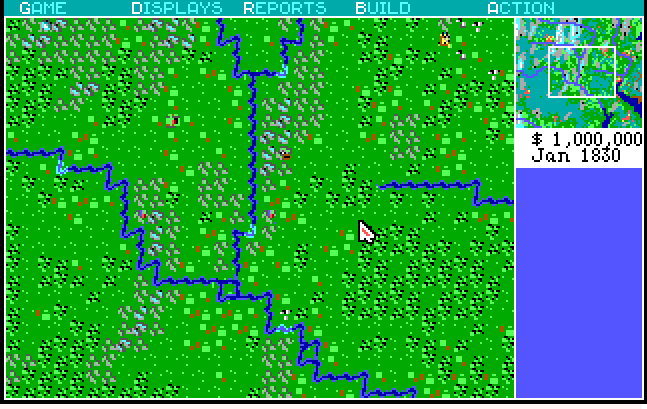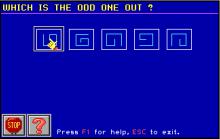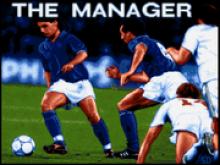Railroad Tycoon
Press Keyboard right side: Alt+Enter keys to switch to full screen game play, and Alt+Enter keys to return.
How to play Railroad Tycoon
Game only runs in keyboard/mouse mode/you need to use the number keypad on a full keyboard, number lock on! to build tracks.., remember to be in detailed view. North numeric keypad `8' key Northeast numeric keypad `9' key East numeric keypad `6' key Southeast numeric keypad `3' key South numeric keypad `2' key Southwest numeric keypad `1' key West numeric keypad `4' key Northwest numeric keypad `7' key
Railroad Tycoon Description
Railroad Tycoon - The Pioneer of Classic Railroad Simulations
Railroad Tycoon is a game that defined an entire genre. Released in 1990, this groundbreaking simulation game puts players in charge of building and managing their very own railroad empire. With its unique blend of strategy, business management, and logistical challenges, Railroad Tycoon remains a fan favorite among retro train games and classic simulation enthusiasts.
Let’s dive into the history, gameplay, and enduring appeal of this iconic railroad management simulation.
The Origins of Railroad Tycoon: A Genre-Defining Game
Railroad Tycoon was developed by Sid Meier and released by MicroProse in 1990. Known for creating legendary strategy games, Meier designed Railroad Tycoon to give players full control over building and running a railway business.

Set during the golden age of railroads, the game captures the excitement of expanding a railroad empire. Players oversee everything from laying tracks to scheduling trains, all while competing against rival tycoons. This combination of strategy, simulation, and history made Railroad Tycoon a trailblazer in the world of management games.
Key Features of Railroad Tycoon
Railroad Tycoon introduced a host of features that set it apart from other games of its time:
- Dynamic Maps: Players could choose regions like North America or Europe to build their railway empires, with maps tailored to real-world geography.
- Economic Management: The game required careful budgeting, balancing revenue from freight and passenger transport with the costs of construction and maintenance.
- Competitors: AI rivals added a layer of competition, forcing players to outthink and outperform their opponents.
- Detailed Logistics: Players managed every detail, from train schedules to cargo selection, ensuring smooth operations and profitability.
- Historical Context: The game was steeped in railroad history, with trains and technologies evolving as time progressed.
These features combined to create an immersive and rewarding experience that has stood the test of time.
Relive the Golden Era: Play Railroad Tycoon Online
For fans eager to revisit this classic, Railroad Tycoon is available online through Classic Reload. These emulators allow you to play Railroad Tycoon in its original form, complete with retro graphics and authentic gameplay.

Whether you’re a longtime fan or new to the game, playing this game online is the perfect way to experience the challenge and thrill of building a railway empire.
The Strategic Appeal of Railroad Tycoon
One of the reasons Railroad Tycoon remains so popular is its focus on strategy. The game challenges players to think critically and plan ahead, balancing short-term needs with long-term goals.
For instance, players must decide where to lay tracks, which trains to buy, and how to prioritize resources. Each decision impacts profitability, making the game a test of both business acumen and logistical skill.
This depth of gameplay ensures that no two playthroughs are ever the same, keeping players engaged even decades after its release.
Why Railroad Tycoon Stands Out Among Retro Train Games
Railroad strategy games often owe their success to the foundation laid by Railroad Tycoon. Here’s why it remains a standout title:
- Historical Accuracy: The game immerses players in the historical context of the railroad boom, offering a unique blend of entertainment and education.
- Replayability: With dynamic maps, evolving technologies, and endless strategies, the game offers nearly limitless replay value.
- Engaging Gameplay: From building routes to managing finances, every aspect of the game is designed to challenge and reward players.
- Nostalgic Charm: The retro graphics and simple yet effective design capture the essence of early PC gaming.
Fun Facts About Railroad Tycoon
- First in Its Genre: Railroad Tycoon is considered the first railroad management simulation, inspiring countless successors.
- Sid Meier’s Vision: The game’s creator, Sid Meier, drew inspiration from his fascination with trains and their role in economic development.
- Innovative AI: The game’s rival tycoons were among the most advanced AI competitors in gaming at the time.
- Multiple Platforms: Railroad Tycoon was released for MS-DOS, Amiga, and Macintosh, ensuring it reached a wide audience.
- Award-Winning: The game received critical acclaim, including awards for its innovative gameplay and strategic depth.
The Legacy of Railroad Tycoon
More than three decades after its release, Railroad Tycoon continues to be celebrated as a pioneer of the simulation genre. Its influence can be seen in modern railroad games, which borrow heavily from its mechanics and design.
For those who enjoy classic railroad simulation or want to experience the origins of a beloved genre, Railroad Tycoon is a must-play. With platforms like Classic Reload offering the game online, it’s easier than ever to revisit this timeless masterpiece.
Railroad Tycoon isn’t just a game—it’s a testament to the power of strategy, creativity, and innovation in gaming. Whether you’re managing cargo or competing with rival tycoons, this classic game offers an unparalleled journey through the golden age of railroads.
Takeaways To Remember
The player may start companies in any of four geographic locales: the Western United States, Northeast United States, England, or Europe. The company starts with one million dollars in capital; half equity, half a loan. The company may raise additional capital through the sale of bonds.
The player manages the business as described above and may also handle individual train movement and build additional industries. The game also has other railroad companies attempting to put the player out of business with stock dealings and "Rate Wars".
There are four types of stations: Signal Tower, Depot, Station, and Terminal. The Signal Tower acts as a passing loop and may control movements. The rest service surrounding areas: the Depot serves its own square and the adjoining eight squares, the Station takes another ring, and the Terminal handles up to three squares away. The player can build at most 32 stations. When the player builds the first station they also build their first engine shop. Each engine shop is the manufacturing area for the player's different trains. The player can upgrade and downgrade Depots, Stations, and Terminals. Other facilities such as cool stores and hotels may be added.
Once the player builds a station they can build their first train (of the 32 permitted) at any engine shop. The player then can add cars to the train and send it on its way. The player can at any time change the "consist", which is the list of cars the train is to pick up at the various stations along the way. These include pure mail and passenger cars and specialized freight cars for each of the other nine types of commodity produced in the game.
The player can continue to build the track network and build stations until the player runs out of funds. The game runs for a century, with accounting periods two years long. Stations built or rebuilt in a particular accounting period pay the player double freight rates for everything they purchase in that period. It can be worthwhile rebuilding busy ones every two years.
Mail pays much better when delivered quickly. Other cargoes also pay better for faster delivery, but at the "bulk" end of the scale there is little advantage (the manual incorrectly says there is none). It is usually better to hold a train at a source station until several bulk cars are full before setting off.
Train speed is a factor to be considered when laying track. Saving money up front by laying track straight over a mountain instead of around on the plains or through an expensive tunnel may cause slow trains which lose money in the long run. Similar considerations apply to ferries, which are expensive and slow-running but may in some cases be economic if they greatly shorten a distance.
Not every station buys everything offered to it. Some good producers buy nothing. There are two alternatives the player can choose between: Simple Economy (where, for example, a station serving two or more cities will buy anything) and Complex Economy (where "two cities" will buy mail, passengers, and a couple of other products; "four villages" will buy passengers and different freight products; only a station with a steel mill will buy coal; and other products have other buyer types). There are product variations over the four geographical scenarios.
Cheats/Hints/Walkthroughs for Railroad Tycoon
No posted cheats for this game yet.

Railroad Tycoon - additional information
















